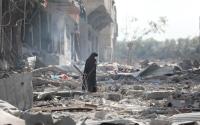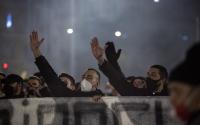Published on Wednesday, March 17, 2004 by TomPaine.comMark Engler
One year after the start of war in Iraq, the peace movement in the United States faces an unusual predicament. Critics of the invasion had many of their key arguments vindicated in the past year, as President Bush's case for war has collapsed. Likewise, activists can take substantial credit for emboldening Democratic criticisms of the Bush administration and for keeping war-related scandals in the spotlight. Yet even as we sense that greater space for progressive activism in the country is opening, it has been hard to maintain a sense of unity and purpose within the peace movement itself.
On March 20, the one-year anniversary of the U.S.-led invasion of Iraq, opponents of the war and the ongoing occupation will stage protests and memorials in countries across the globe. The actions will recall the massive demonstrations that took place before the war. However, they will be far smaller than the protests of early 2003.
This set of circumstances raises two key questions: What has the peace movement accomplished? And where do we go from here?
Last year, the Bush administration's push for war with Iraq faced a huge wave of international dissent, culminating in the coordinated worldwide demonstrations of Feb. 15, 2003. As part of the "Cities for Peace" campaign, some 140 U.S. communities passed anti-war resolutions, including large cities like Chicago, Detroit and Los Angeles, as well as small ones like Telluride, Colo., Salisbury, Conn. and Des Moines, Iowa. Immediately after the bombing began, direct actions in San Francisco produced a remarkable 2,300 arrests.
However, the movement's momentum slowed in the weeks following the first mass arrests. The shift was compounded by a dramatic change in mood nationally as the invasion of Iraq swiftly came to an end and the regime change heralded as a success.
After the invasion, a perception emerged that the movement was a failure because the Bush administration went forward with its plans. It is true that peace activists could not stop the start of war. But there is no doubt that, in more general terms, the visible, outspoken, and sometimes disruptive global protests significantly shaped public understanding of the war.
In the wake of the protests on Feb. 15, 2003, The New York Times famously labeled "world public opinion" as the second of "two superpowers on the planet." In several countries, most notably Spain (where the anti-war left just succeeded in ousting a pro-war government) forces standing in opposition to the invasion and occupation of Iraq have significantly altered the balance of power within their governments. It is possible that international outrage stopped the administration from fulfilling neoconservative desires to follow-up on the invasion of Iraq with assaults on Syria and Iran.
Domestically, protesters can also point to specific effects of their actions. Due to strong expressions of dissent, the war in Iraq was framed as a fiercely disputed affair. The taint of controversy limited the surge of support that any U.S. president can expect to receive when commanding troops overseas. The relentless scrutiny and criticism by the peace movement of the faulty case for invasion would ultimately gain mainstream traction and leave the president flailing to defend his wartime lies and deceptions. The peace movement also helped to empower a mainstream Democratic critique of Bush's war. Activists soon found many of their arguments voiced in the presidential primaries. This came to fruition most visibly in the Dean campaign, which in turn helped to push the entire Democratic field in an anti-war direction.
While peace activists seemed demoralized by a triumphal Bush administration throughout much of spring 2003, anti-war sentiment began to rebound by autumn. The sustained hostilities and attacks on U.S. servicemen in Iraq disproved the neoconservative vision of an easy reconstruction, suggesting grim and difficult times ahead. Increasing U.S. casualties fermented growing discontent among military families about the war's necessity.
Movement critiques helped to discredit the popular myth of a link between Hussein and Al Qaeda, disrupting contentions that the Iraq war was an effective way to fight terrorism. Denunciations of the administration's corporate pandering appeared especially trenchant following a series of no-bid contracts offered to well-connected U.S. businesses, as well as after persistent scandals about Halliburton profiteering. Finally, the administration's misuse of police powers to target opponents of the war helped to feed a backlash of civil libertarians calling for the repeal of the USA PATRIOTAct.
So where does the peace movement go from here?
Since the end of combat operations, peace activists have struggled to present a unified message, structured campaign goals, or a plan for escalating dissent. The call to "Bring the Troops Home Now" is not universally accepted, even among those who oppose the U.S. occupation, and it often muddies the waters by focusing discussion on technical plans for how the international community can play a greater role in furthering Iraqi sovereignty. The slogan for the March 20 protests, "The World Still Says No to War," is not fashioned to provide a new alternative or to convey a sense of fresh demands.
In terms of critical mass, unified message and clear goals, the push to "Beat Bush" is likely the only thing on the map of the U.S. peace movement that qualifies as a true strategy. This is by no means uncontroversial amongst activists, and many leading peace movement organizations have refrained from explicitly endorsing an anti-Bush electoral effort. Yet in contrast to four years ago, when many progressives supported the Nader campaign and felt that a ripe moment for third-party insurgency had arrived, a wide range of left-of-center citizens are now unrepentantly joining forces to oust the current administration.
It hardly needs to be argued that there are many good reasons for this. However, a "Beat Bush" strategy also has its limits. The first and most obvious is that John Kerry's "anti-war" position is barely passable—something he belatedly adopted after initially voting to authorize an invasion.
The newspaper War Times, while celebrating Bush's poor showing in the polls, argues for the need "to continue to push our peace demand ourselves—and push Democrats to follow." Many activists would take from this sentiment a plan for "critical support" of John Kerry. Of course, when it comes to mainstream presidential candidates, the U.S. Left has proven itself better at the "critical" part of things than at "support." Along similar lines, United for Peace and Justice's 12-month strategy paper speaks of "shaping the debate." This is an admirable goal, but probably is too ambitious and diffuse to plan around effectively.
Looking at what unique strengths the peace movement brings to a larger "Beat Bush" coalition, a more specific job emerges for anti-war activists to tackle: Namely, the job of taking the war away from President Bush as a campaign asset. When the White House tries to portray its Iraq conquest as a victory for freedom and justice in the world, peace activists have a clear mandate to challenge the rosy story line, to expose the lies, and to highlight the true costs of neoconservatism. Already, we have made considerable strides in this direction, forcing the administration into what The New York Times describes as a "slow retreat... a day-by-day, fact-by-fact backing away from assertions they made with such confidence nine months ago."
Writer Naomi Klein, among others, is now forcefully arguing that the privatization of Iraq's economy will be a vital front in this effort. As each of the leading justifications for war—first the weapons of mass destruction, then the links with Al Qaeda—has fallen away, Bush has increasingly been forced to fall back on humanitarian reasoning. His apologists now frame the war as an effort to promote democracy. It will be incumbent upon peace activists, drawing on a wider analysis of global injustices, to raise questions about what version of "freedom" the White House is actually offering.
After all, what kind of democracy is the Bush administration promoting when the occupying authority has already sold away the Iraqi economy—where virtually everything is newly privatized, where there are no limits on the controlling interests of foreign corporations, where profits are expatriated, and where pre-arranged Structural Adjustment programs put handcuffs on national policymakers? Freedom for a well-connected corps of multinational profiteers and true self-determination for the Iraqi people are two very distinct things. It's the job of the peace movement to publicize the difference in a way that can resonate with a large portion of the American electorate.
A modest start to our renewed efforts to make the costs of war an election issue will be participating in protests on March 20. This means joining vigils taking place throughout the world. Or, better yet, marching with military families to the White House from the Dover, Del. Air Force base, a site where the media is banned and the Iraq war dead arrive. Pictures of the families, the marchers, and the mourners are images of dissent that the president would rather not see in advance of the November elections. But for a movement rebuilding momentum, they would be only the beginning.
Mark Engler, a writer based in New York City, is a commentator for Foreign Policy in Focus and for the Global Beat Syndicate. Research assistance for this article provided by Jason Rowe.






